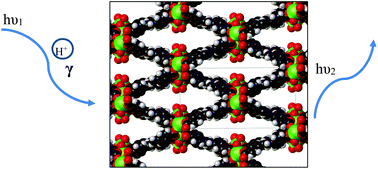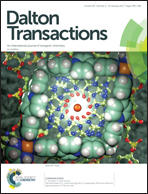Mesoporous stilbene-based lanthanide metal organic frameworks: synthesis, photoluminescence and radioluminescence characteristics†
Abstract
Ultra large pore isostructural metal organic frameworks (MOFs) which exhibit both photoluminescence and scintillation properties, were synthesized from trans-4,4′-stilbenedicarboxylic acid (H2L) and trivalent lanthanide (Ln) metal salts under solvothermal conditions (Ln = Er3+ (1) and Tm3+ (2)). This new class of mesoporous materials is a non-interpenetrating network that features ultra-large diamond shaped pores of dimensions with approximate cross-sectional dimensions of 28 Å × 12 Å. The fully deprotonated ligand, L, is isolated and rigidified as it serves as the organic linker component of the MOF structure. Its low density unit cells possess asymmetric units with two crystallographically independent Ln3+ ions in seven coordinate arrangements. A distinct feature of the structure is the bis-bidentate carboxylate groups. They serve as a ligand that coordinates two Ln(III) ions while each L connects four Ln(III) ions yielding an exceptionally large diamond-shaped rectangular network. The structure exhibits ligand-based photoluminescence with increased lifetime compared to free stilbene molecules on exposure to UV radiation, and also exhibits strong scintillation characteristics, comprising of both prompt and delayed radioluminescence features, on exposure to ionizing radiation.



 Please wait while we load your content...
Please wait while we load your content...